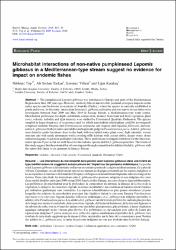| dc.contributor.author | Top, Nildeniz | |
| dc.contributor.author | Tarkan, Ali Serhan | |
| dc.contributor.author | Vilizzi, Lorenzo | |
| dc.contributor.author | Karakuş, Uğur | |
| dc.date.accessioned | 2020-11-20T15:03:06Z | |
| dc.date.available | 2020-11-20T15:03:06Z | |
| dc.date.issued | 2016 | |
| dc.identifier.issn | 1961-9502 | |
| dc.identifier.uri | https://doi.org/10.1051/kmae/2016023 | |
| dc.identifier.uri | https://hdl.handle.net/20.500.12809/2663 | |
| dc.description | WOS: 000390394000043 | en_US |
| dc.description.abstract | The pumpkinseed Lepomis gibbosus was introduced to Europe and parts of the Mediterranean Region more than 100 years ago. However, relatively little is known of its potential ecological impacts on the native species and freshwater ecosystems of Anatolia (Turkey), where the species is currently established in ponds and rivers. In this study, interactions between L. gibbosus and native and non-native stream fishes were investigated between June 2009 and May 2010 in Saricay Stream, a Mediterranean-type water course. Microhabitat preferences for depth, substratum composition, distance from bank and from vegetation, plant cover, velocity, turbidity and light intensity were studied by Constrained Quadratic Ordination. The species sampled in larger frequency of occurrence (and for which microhabitat relationships could be investigated) comprised endemic Smyrna chub Petroleuciscus smyrnaeus and Aegean chub Squalius fellowesii, and nonnative L. gibbosus (both juveniles and adults) and topmouth gudgeon Pseudorasbora parva. Adult L. gibbosus were found to prefer locations closer to the bank with less turbid water, plant cover, light intensity, woody structure and with sandy substratum whilst avoiding riffle habitats with coarser debris, deeper water, dense submersed aquatic vegetation and higher velocities. These preferences overlapped with those for the other nonnative species P. parva, but not with those for the endemic species and for L. gibbosus juveniles. The results of this studysuggest that the potential for adverseimpacts throughcompetition for habitat of adult L. gibbosus with the native fish fauna is not apparent in Saricay Stream. | en_US |
| dc.description.sponsorship | Research Fund of Mugla Sitki Kocman UniversityMugla Sitki Kocman University [09/28] | en_US |
| dc.description.sponsorship | This study was supported by the Research Fund of Mugla Sitki Kocman University (Project No: 09/28). We thank the General Directorate of Protection and Control, Ministry of Agriculture and Rural Affairs, Republic of Turkey for providing permission to carry out sampling for the present study. | en_US |
| dc.item-language.iso | eng | en_US |
| dc.publisher | Edp Sciences S A | en_US |
| dc.item-rights | info:eu-repo/semantics/openAccess | en_US |
| dc.subject | Endemic | en_US |
| dc.subject | Invasion | en_US |
| dc.subject | Lotic System | en_US |
| dc.subject | Constrained Quadratic Ordination (CQO) | en_US |
| dc.title | Microhabitat interactions of non-native pumpkinseed Lepomis gibbosus in a Mediterranean-type stream suggest no evidence for impact on endemic fishes | en_US |
| dc.item-type | article | en_US |
| dc.contributor.department | MÜ, Su Ürünleri Fakültesi, Su Ürünleri Temel Bilimleri Bölümü | en_US |
| dc.contributor.authorID | 0000-0001-8628-0514 | |
| dc.contributor.institutionauthor | Top, Nildeniz | |
| dc.contributor.institutionauthor | Tarkan, Ali Serhan | |
| dc.contributor.institutionauthor | Karakuş, Uğur | |
| dc.identifier.doi | 10.1051/kmae/2016023 | |
| dc.identifier.issue | 417 | en_US |
| dc.relation.journal | Knowledge and Management of Aquatic Ecosystems | en_US |
| dc.relation.publicationcategory | Makale - Uluslararası Hakemli Dergi - Kurum Öğretim Elemanı | en_US |


















